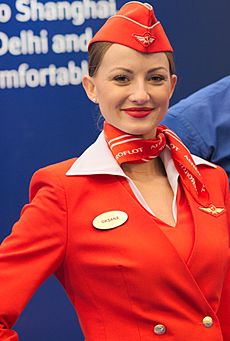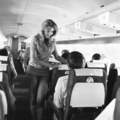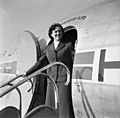Flight attendant facts for kids

A flight attendant, also known as steward/stewardess or air host/air hostess, is a member of the aircrew aboard commercial flights, many business jets and some government aircraft. Collectively called cabin crew, flight attendants are primarily responsible for passenger safety and comfort.
Contents
Responsibilities
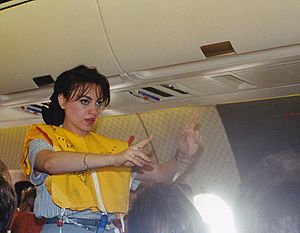
Prior to each flight, flight attendants and pilots go over safety and emergency checklists, the locations of emergency equipment and other features specific to that aircraft type. Boarding particulars are verified, such as special needs passengers, small children travelling alone, or VIPs. Weather conditions are discussed including anticipated turbulence. A safety check is conducted to ensure equipment such as life-vests, torches (flash lights) and firefighting equipment are on board and in proper condition. They monitor the cabin for any unusual smells or situations. They assist with the loading of carry-on baggage, checking for weight, size and dangerous goods. They make sure those sitting in emergency exit rows are willing and able to assist in an evacuation. They then give a safety demonstration or monitor passengers as they watch a safety video. They then must "secure the cabin" ensuring tray tables are stowed, seats are in their upright positions, armrests down and carry-ons stowed correctly and seat belts are fastened prior to take-off.
Once up in the air, flight attendants will usually serve drinks and/or food to passengers using an airline service trolley. When not performing customer service duties, flight attendants must periodically conduct cabin checks and listen for any unusual noises or situations. Checks must also be done on the lavatory to ensure the smoke detector hasn't been disabled or destroyed and to restock supplies as needed. Regular cockpit checks must be done to ensure the health and safety of the pilot(s). They must also respond to call lights dealing with special requests. During turbulence, flight attendants must ensure the cabin is secure. Prior to landing, all loose items, trays and rubbish must be collected and secured along with service and galley equipment. All hot liquids must be disposed of. A final cabin check must then be completed prior to landing. It is vital that flight attendants remain aware as the majority of emergencies occur during take-off and landing. Upon landing, flight attendants must remain stationed at exits and monitor the airplane and cabin as passengers disembark the plane. They also assist any special needs passengers and small children off the airplane and escort children, while following the proper paperwork and ID process to escort them to the designated person picking them up.
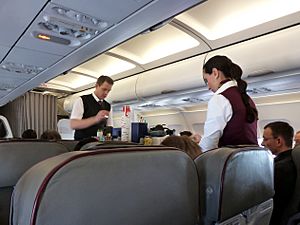
Flight attendants are trained to deal with a wide variety of emergencies, and are trained in first aid. More frequent situations may include a bleeding nose, illness, small injuries, intoxicated passengers, aggressive and anxiety stricken passengers. Emergency training includes rejected take-offs, emergency landings, cardiac and in-flight medical situations, smoke in the cabin, fires, depressurization, on-board births and deaths, dangerous goods and spills in the cabin, emergency evacuations, hijackings, and water landings.
Qualifications
Training
Flight attendants are normally trained in the hub or headquarters city of an airline over a period that may run from four weeks to six months, depending on the country and airline. The main focus of training is safety, and attendants are evaluated for each type of aircraft in which they work. One of the most elaborate training facilities was Breech Academy, which Trans World Airlines (TWA) opened in 1969 in Overland Park, Kansas. Other airlines also sent their attendants to the school. However, during the fare wars, the school's viability declined and it closed around 1988.
Safety training includes, but is not limited to: emergency passenger evacuation management, use of evacuation slides/life rafts, in-flight firefighting, first aid, CPR, defibrillation, ditching/emergency landing procedures, decompression emergencies, crew resource management, and security.
In the United States, the Federal Aviation Administration requires flight attendants on aircraft with 20 or more seats and used by an air carrier for transportation to hold a Certificate of Demonstrated Proficiency. This is not considered to be the equivalent of an airman certificate (license), although it is issued on the same card stock. It shows that a level of required training has been met. It is not limited to the air carrier at which the attendant is employed (although some initial documents showed the airlines where the holders were working), and is the attendant's personal property. It does have two ratings, Group 1 and Group 2 (listed on the certificate as "Group I" and "Group II"). Either or both of these may be earned depending upon the general type of aircraft, (propeller or turbojet), on which the holder has trained.
There are also training schools, not affiliated with any particular airline, where students generally not only undergo generic, though otherwise practically identical, training to flight attendants employed by an airline, but also take curriculum modules to help them gain employment. These schools often use actual airline equipment for their lessons, though some are equipped with full simulator cabins capable of replicating a number of emergency situations. In some countries, such as France, a degree is required, together with the Certificat de formation à la sécurité (Safety training certificate).
Language
Multilingual flight attendants are often in demand to accommodate international travellers. The languages most in demand, other than English, are French, Russian, Hindi, Spanish, Mandarin, Cantonese, Bengali, Japanese, Arabic, German, Portuguese, Italian, Turkish In the United States, airlines with international routes pay an additional stipend for language skills on top of flight pay, and some airlines hire specifically for certain languages when launching international destinations.
Height
Most airlines have height requirements for safety reasons, making sure that all flight attendants can reach overhead safety equipment. Typically, the acceptable height for this is 150 to 185 cm (4 ft 11 in to 6 ft 1 in) tall. Some airlines, such as EVA Air, have height requirements for purely aesthetic purposes. Regional carriers using small aircraft with low ceilings can have height restrictions.
Uniforms and presentation

The first flight attendant uniforms were designed to be durable, practical, and inspire confidence in passengers. In the 1930s, the first female flight attendants dressed in uniforms resembling nurses' outfits. The first female flight attendants for United Airlines wore green berets, green capes and nurse's shoes. Other airlines, such as Eastern Air Lines, actually dressed female flight attendants in nurses' uniforms. Both male and female flight attendants for Hawaiian Airlines wear aloha shirts as their uniform.
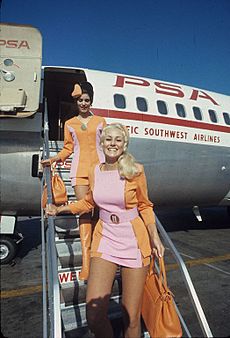
Many early uniforms had a strongly military appearance; hats, jackets, and skirts showed simple straight lines and military details like epaulettes and brass buttons. Many uniforms had a summer and winter version, differentiated by colours and fabrics appropriate to the season: navy blue for winter, for example, khaki for summer. But as the role of women in the air grew, and airline companies began to realise the publicity value of their female flight attendants, more feminine lines and colours began to appear in the late 1930s and early 1940s. Some airlines began to commission designs from high-end department stores and still others called in noted designers or even milliners to create distinctive and attractive apparel.
During the 1960s, Pacific Southwest Airlines (PSA) was known for brightly coloured female flight attendant uniforms that included short miniskirts. In the early 1970s, the uniform changed to hotpants.
Since the 1980s to present, Asian airlines, especially national flag carrier ones, usually feature the traditional dress and fabrics of their respective country in their female flight attendants' uniform. It was meant as a marketing strategy to showcase their national culture as well as to convey welcoming warmth and hospitality. For example, Thai Airways flight attendants are required to change from their corporate purple suits into traditional Thai costume prior to passengers boarding. While the uniform of Garuda Indonesia female flight attendants is a modified kebaya, inspired by the traditional batik motif of Parang Gondosuli, the motif is called Lereng Garuda Indonesia. Malaysian and Singapore Airlines flight attendants wear batik prints in their uniform. Vietnam Airlines flight attendants wear red áo dài and Air India flight attendants wear a sari on all passenger flights.
During the mid-1990s, several US-based airlines required female flight attendants to wear shoes with heels. Minimum heel heights ranged from one-half inch to the two inches mandated by USAir. Flight attendants at times avoided censure by changing into more comfortable shoes during flights, since their supervisors were less likely to be present there.
In 2015, the Israeli airline El Al introduced a requirement that female flight attendants wear high heels until passengers had been seated. The airline's workers' union stated that the requirement would endanger the health and safety of the flight attendants and instructed its members to ignore the rule. Later that year the requirement was removed.
Until 2016, some female crew members on British Airways were required to wear British Airways' standard "ambassador" uniform, which has not traditionally included trousers.
In 2019, Virgin Atlantic began to allow its female flight attendants to wear trousers and not wear makeup.
Health conditions
A 2018 study found higher instances of breast cancer, melanoma, uterine, gastrointestinal, cervical, and thyroid cancers reported in flight attendants in contrast to the general population. Specifically, the increased cancer cases reported were seen in breast cancer (3.4% of flight crew compared to 2.3% in the general population - a 50% increase), cervical cancer (1.0% compared to 0.70%), gastrointestinal cancer (0.47% compared to 0.27% – a 74% increase), thyroid cancer (0.67% compared to 0.56%) and higher rates of both melanoma and non-melanoma skin cancers with reports of the latter increasing with every five years spent in the job. The study did not look into what causes this increase, but the authors said increased exposure to ionizing radiation from time spent in the thinner upper atmosphere, poor cabin air quality as well as disrupted sleep and meal cycles could be factors.
Other studies have found increased rates of breast and skin cancer, reduced respiratory health, adverse reproductive and perinatal outcomes, musculoskeletal injuries, and higher rates of mental health conditions in flight attendants.
In advertising
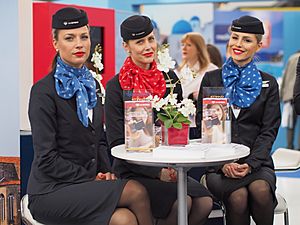
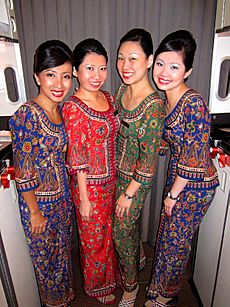
In the 1960s and 1970s, many airlines began advertising the attractiveness and friendliness of their stewardesses. National Airlines began a "Fly Me"; campaign using attractive female flight attendants with taglines such as "I'm Lorraine. Fly me to Orlando." (A low budget 1973 film about three flight attendants, Fly Me, starring Lenore Kasdorf, was based on the ad campaign.) Braniff International Airways presented a campaign known as the "Air Strip" with similarly attractive young female flight attendant changing uniforms mid-flight. In the United States, many airlines had a policy such that only unmarried women could be flight attendants, as well as a mandatory retirement age of 32 for stewardesses because of the belief women would be less appealing and attractive after this age. Many of the women were recruited as seniors in college and in beauty pageants. In 1968, the EEOC declared age restrictions on flight attendants' employment to be illegal sex discrimination under Title VII of the Civil Rights Act of 1964.
Flight attendant Roz Hanby became a minor celebrity when she became the face of British Airways in their "Fly the Flag" advertising campaign over a seven-year period in the 1980s. Singapore Airlines is currently one of the few airlines still choosing to use the image of their female flight attendants, known as Singapore Girls, in their advertising material. However, this is starting to be phased out, in favour of advertising which emphasises the modernity of their fleet.
Gallery
-
Air Dolomiti flight attendant
-
Scandinavian Airlines flight attendants in the 1960s
-
Southwest Airlines flight attendant
See also
 In Spanish: Auxiliar de vuelo para niños
In Spanish: Auxiliar de vuelo para niños


